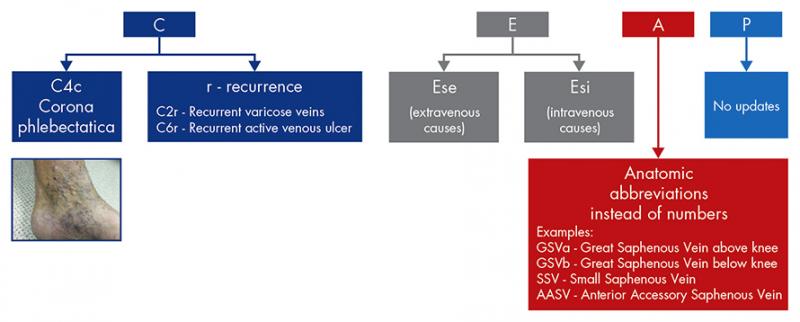CEAP classification
- Clinical (C 0-6, a=asymptomatic, s=symptomatic)
- Etiologic (c, p ,s)
- Anatomic (s, d, p)
- Pathophysiologic (r, o)
Clinical classification (C 0-6)
- Class 0: No visible or palpable signs of venous disease
- Class 1 (a,s): Teleangiectasias or reticular veins
- Class 2 (a,s): Varicose veins
- Class 2r: Recurrent varicose veins
- Class 3 (a,s): Edema
- Class 4a (a,s): Cutaneous alteration: Pigmentation, eczema
- Class 4b (a,s): Lipodermatosclerosis, atrophic blanche
- Class 4c: Corona phlebectatica
- Class 5:(a,s): Healed venous ulcer
- Class 6: Active venous ulcer
- Class 6r: Recurrent active venous ulcer
Summary of etiologic (E) classification
- Ep = Primary
- Es = Secondary
- Esi = Secondary e intravenous
- Ese = Secondary e extravenous
- Ec = Congenital
- En = No cause identified
Anatomic classification (As, Ad, Ap)
- As = Superficial veins
- Ad = Deep veins
- Ap = Perforator veins
- Superficial Veins: As
- 1 – teleangiectasia, internal saphenous reticular veins:
- 2 – above the knee veins
- 3 – below the knee superficial veins
- 4 – external saphenous vein
- 5 – non saphenous district veins
- Deep veins: Ap
- 6 – inferior vena cava, iliac vein
- 7 – common vein
- 8 – internal
- 9 – exterrnal
- 10 – genital pelvic veins,
- 11 – common femoral vein
- 12 – deep
- 13 – superficial
- 14 – popliteal vein
- 15 – crural veins: posterior tibial veins, anterior tibial veins, peroneal veins
- 16 – muscle veins: gemellar veins, soleal veins
- Perforating veins: Ap
- 17 – at the level of the tight
- 18 – at the level of the leg
Physiopathological classification (Pr, Po)
- Pr = reflux
- Po = obstruction
- Pr+o = reflux + obstruction
- Pn = No pathophysiology identified

Lurie F, Passman M, Meisner M, Dalsing M, Masuda E, Welch H, Bush RL, Blebea J, Carpentier PH, De Maeseneer M, Gasparis A, Labropoulos N, Marston WA, Rafetto J, Santiago F, Shortell C, Uhl JF, Urbanek T, van Rij A, Eklof B, Gloviczki P, Kistner R, Lawrence P, Moneta G, Padberg F, Perrin M, Wakefield T. The 2020 update of the CEAP classification system and reporting standards. J Vasc Surg Venous Lymphat Disord. 2020 May;8(3):342-352. doi: 10.1016/j.jvsv.2019.12.075. Epub 2020 Feb 27. PMID: 32113854.
NOTE: The published material is intended to provide the registered doctor to the Nautilus WEB portal with quick access to information from the current literature, recommendations / suggestions of the major Guidelines, the knowledge currently shared by the scientific community and the experience of doctors who practice discipline in our country, in accordance with the state of knowledge at the time of preparation of the texts and can not therefore be guaranteed their accuracy and completeness. The information given should in no way replace an appropriate clinical judgment in the individual patient, who may also completely ignore the information reported and therefore can not be held responsible for the results of decisions taken on their basis. The Editorial Staff takes no responsibility for any inaccuracies or errors in the original scientific texts or in the published text. Finally, it is recalled that the reading of the texts reported is reserved exclusively for the public of the surgeon doctors formally registered at the Nautilus WEB portal.
